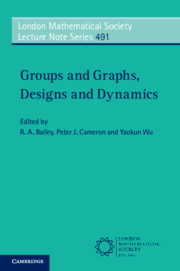522 results
The Rapid ASKAP Continuum Survey III: Spectra and Polarisation In Cutouts of Extragalactic Sources (SPICE-RACS) first data release – CORRIGENDUM
-
- Journal:
- Publications of the Astronomical Society of Australia / Volume 41 / 2024
- Published online by Cambridge University Press:
- 03 June 2024, e039
-
- Article
-
- You have access
- Open access
- HTML
- Export citation
Preface
-
- Book:
- Groups and Graphs, Designs and Dynamics
- Published online:
- 11 May 2024
- Print publication:
- 30 May 2024, pp xiii-xvi
-
- Chapter
- Export citation
3 - Laplacian eigenvalues and optimality
-
-
- Book:
- Groups and Graphs, Designs and Dynamics
- Published online:
- 11 May 2024
- Print publication:
- 30 May 2024, pp 176-265
-
- Chapter
- Export citation
Contents
-
- Book:
- Groups and Graphs, Designs and Dynamics
- Published online:
- 11 May 2024
- Print publication:
- 30 May 2024, pp v-x
-
- Chapter
- Export citation
Frontmatter
-
- Book:
- Groups and Graphs, Designs and Dynamics
- Published online:
- 11 May 2024
- Print publication:
- 30 May 2024, pp i-iv
-
- Chapter
- Export citation
Author Index
-
- Book:
- Groups and Graphs, Designs and Dynamics
- Published online:
- 11 May 2024
- Print publication:
- 30 May 2024, pp 423-426
-
- Chapter
- Export citation
Authors
-
- Book:
- Groups and Graphs, Designs and Dynamics
- Published online:
- 11 May 2024
- Print publication:
- 30 May 2024, pp xi-xii
-
- Chapter
- Export citation
Subject Index
-
- Book:
- Groups and Graphs, Designs and Dynamics
- Published online:
- 11 May 2024
- Print publication:
- 30 May 2024, pp 427-434
-
- Chapter
- Export citation
Evaluating the vegetative and reproductive response of hemp (Cannabis sativa) to simulated off-target events of 2,4-D and dicamba
-
- Journal:
- Weed Technology / Accepted manuscript
- Published online by Cambridge University Press:
- 23 May 2024, pp. 1-20
-
- Article
-
- You have access
- Open access
- Export citation
Sperlingite, (H2O)K(Mn2+Fe3+)(Al2Ti)(PO4)4[O(OH)][(H2O)9(OH)]⋅4H2O, a new paulkerrite-group mineral, from the Hagendorf-Süd pegmatite, Oberpfalz, Bavaria, Germany.
-
- Journal:
- Mineralogical Magazine / Accepted manuscript
- Published online by Cambridge University Press:
- 20 May 2024, pp. 1-27
-
- Article
-
- You have access
- Export citation

Groups and Graphs, Designs and Dynamics
-
- Published online:
- 11 May 2024
- Print publication:
- 30 May 2024
Residue analysis suggests ritual use of tobacco at the ancient Mesoamerican city of Cotzumalhuapa, Guatemala
-
- Article
-
- You have access
- Open access
- HTML
- Export citation
Chapter 39 - Termination of Pregnancy at Different Gestational Phases
- from Section 2B - Sexual and Reproductive Healthcare: Termination of Pregnancy
-
-
- Book:
- Textbook of Contraception, Sexual and Reproductive Health
- Published online:
- 16 January 2024
- Print publication:
- 25 January 2024, pp 239-242
-
- Chapter
- Export citation
Chapter 36 - Termination of Pregnancy
- from Section 2B - Sexual and Reproductive Healthcare: Termination of Pregnancy
-
-
- Book:
- Textbook of Contraception, Sexual and Reproductive Health
- Published online:
- 16 January 2024
- Print publication:
- 25 January 2024, pp 223-228
-
- Chapter
- Export citation
Chapter 37 - Termination of Pregnancy
- from Section 2B - Sexual and Reproductive Healthcare: Termination of Pregnancy
-
-
- Book:
- Textbook of Contraception, Sexual and Reproductive Health
- Published online:
- 16 January 2024
- Print publication:
- 25 January 2024, pp 229-232
-
- Chapter
- Export citation
The Rapid ASKAP Continuum Survey III: Spectra and Polarisation In Cutouts of Extragalactic Sources (SPICE-RACS) first data release
-
- Journal:
- Publications of the Astronomical Society of Australia / Volume 40 / 2023
- Published online by Cambridge University Press:
- 30 August 2023, e040
-
- Article
-
- You have access
- Open access
- HTML
- Export citation
The Parkes Pulsar Timing Array third data release
-
- Journal:
- Publications of the Astronomical Society of Australia / Volume 40 / 2023
- Published online by Cambridge University Press:
- 19 July 2023, e049
-
- Article
-
- You have access
- Open access
- HTML
- Export citation
Food insecurity during the COVID-19 pandemic who use drugs in Vancouver, Canada
-
- Journal:
- Public Health Nutrition / Volume 26 / Issue 9 / September 2023
- Published online by Cambridge University Press:
- 27 June 2023, pp. 1878-1886
-
- Article
-
- You have access
- Open access
- HTML
- Export citation
A Holistic Search for Megamaser Disks and their Role in Feeding Supermassive Black Holes
-
- Journal:
- Proceedings of the International Astronomical Union / Volume 18 / Issue S380 / December 2022
- Published online by Cambridge University Press:
- 07 February 2024, pp. 57-59
- Print publication:
- December 2022
-
- Article
-
- You have access
- Open access
- Export citation
Evidence for functional improvement in reward anticipation in recent onset schizophrenia after one year of coordinated specialty care
-
- Journal:
- Psychological Medicine / Volume 53 / Issue 13 / October 2023
- Published online by Cambridge University Press:
- 24 November 2022, pp. 6280-6287
-
- Article
-
- You have access
- Open access
- HTML
- Export citation


















